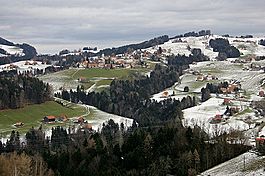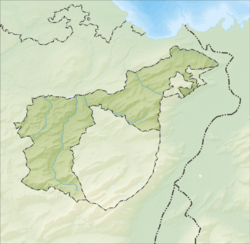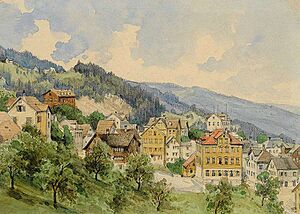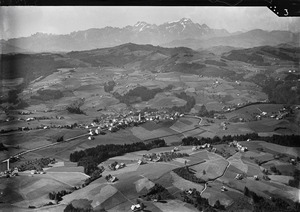Wald, Appenzell Ausserrhoden facts for kids
Quick facts for kids
Wald
|
||
|---|---|---|
 |
||
|
||
| Country | Switzerland | |
| Canton | Appenzell Ausserrhoden | |
| District | n.a. | |
| Area | ||
| • Total | 6.83 km2 (2.64 sq mi) | |
| Elevation | 962 m (3,156 ft) | |
| Population
(Dec 2020 )
|
||
| • Total | 882 | |
| • Density | 129.14/km2 (334.5/sq mi) | |
| Postal code |
9044
|
|
| Surrounded by | Heiden, Oberegg (AI), Rehetobel, Trogen | |
Wald (pronounced "valt") is a small town, also called a municipality, in the canton of Appenzell Ausserrhoden in Switzerland. It's a lovely place known for its beautiful natural surroundings.
Contents
Exploring Wald's Geography
Wald covers an area of about 6.8 square kilometers (which is about 2.6 square miles). A big part of this area, about 66%, is used for farming. This means there are lots of fields and farms.
Another large part, about 28.4%, is covered by forests. Imagine all those trees! The rest of the land, about 5.4%, has buildings and roads. A tiny bit, 0.1%, is made up of rivers or mountains that aren't used for anything else.
Who Lives in Wald?
Wald has a population of about 868 people. In 2008, around 10.1% of the people living in Wald were from other countries. Over the last ten years, the number of people living in Wald has gone down a little bit.
Most people in Wald, about 93.6%, speak German. This is the main language. Some people also speak Serbo-Croatian (2.3%) and French (0.8%).
In 2000, there were slightly more boys and men (51.3%) than girls and women (48.7%) living in Wald.
Education and Jobs in Wald
Many adults in Wald have a good education. About 77.5% of people aged 25 to 64 have finished high school or gone on to higher education, like a university. This shows that education is important in Wald.
Wald has a very low unemployment rate, which means most people who want to work can find a job. Only about 0.58% of people are unemployed.
People in Wald work in different kinds of jobs:
- Farming: About 73 people work in farming, which is called the primary economic sector. There are around 31 farms or businesses related to farming.
- Making Things: Around 133 people work in the secondary sector. This includes jobs like manufacturing or building things. There are 16 businesses in this area.
- Services: About 88 people work in the tertiary sector. These are jobs that provide services, like working in shops, offices, or tourism. There are 29 businesses in this sector.
Wald's Population Through Time
The number of people living in Wald has changed over the years:
- 1980: 695 people
- 1990: 851 people
- 2000: 894 people
- 2005: 874 people
- 2007: 875 people
See also
 In Spanish: Wald (Appenzell) para niños
In Spanish: Wald (Appenzell) para niños







